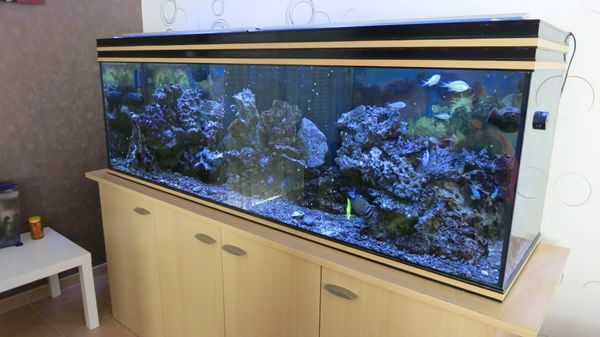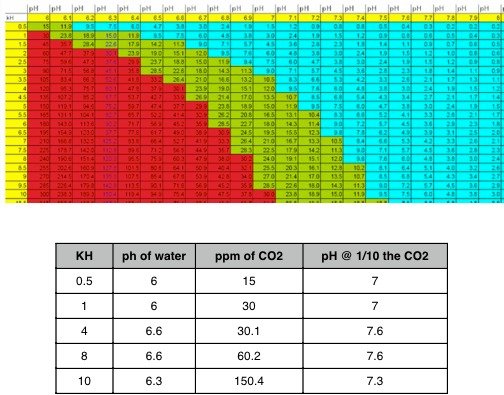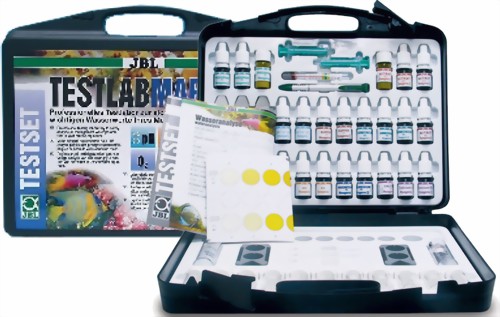Aquarium water parameters
Water is a complex mixture of various parameters, the most important in the aquarium are hardness, carbonate hardness and pH. These three parameters are interrelated: changing one will change the others.

Hardness and pH
The total hardness (TH or DH in French degree, GH in German degree): it corresponds to the calcium and magnesium salts contained in water and results from the combination of carbonate hardness and permanent hardness. The more water is rich in calcium and magnesium salts, the harder it is.
A GH hardness of 5 ° to 10 ° corresponds to a fresh water. We speak more vonlontiers in German degrees, tests giving this value. To convert the TH to GH it is necessary to multiply the TH value by 0.56.
The carbonate hardness (KH in German degree or TAC in French degree): it is the carbonates and bicarbonates of calcium and magnesium which disappear after boiling water. They are therefore temporary. KH acts as a buffer on pH.
The permanent hardness: it is the sulphates and chlorides of calcium which remain present after boiling.
PH: it corresponds to the degree of acidity of the water. Below 7 the pH is acidic, above 7 it is basic, equal to 7, it is neutral. The pH varies during the day: the night decreases because the plants release CO2, the day goes up because the plants consume the CO2 for photosynthesis.
The most important parameter to take into account for the well-being of the fish is the total hardness. The fish requirements must be met with respect to this parameter. The pH must also be respected, especially for very delicate species such as Discus for example. Some fish need hard water (GH> 15) and basic water (pH> 7) and others, mine in this case, fresh water (GH> 5 <10) and acid (pH < 7).
Lower pH and water hardness

Most tap water is hard and pH basic, so I use reverse osmosis water to reduce hardness and pH. Just buy osmosis water in the aquarium shop and mix it with tap water. This makes it possible to balance the temperatures between the water purchased, that of the tap and that of the tank. It is inadvisable to dump the reverse osmosis water directly into the tank, its very low pH and almost no hardness could cause shock to the fish.
I went from a water with a carbonate hardness of 15 to 5. The carbonated hardness should not be less than 4, otherwise the pH will be very unstable.
Indeed, KH acts as a buffer on the pH. It will be useless to try to lower the pH of a water if the KH is too high: it will not work. Lowering KH also resulted in lower pH (around 8 to 7).
CO2 input or peat filtration can also be used to lower the pH, but once again, if the water is hard (GH and KH), CO2 and peat will have no effect. It could even be harmful.
Other parameters are extremely important in aquariums: they are the nitrite (NO2) and nitrate (NO3) levels. They correspond to the level of pollution of the water.
Nitrites and nitrates
Nitrites are very dangerous for fish, the rate must always be 0.
When starting an aquarium, the filter must be sown with "de-nitrifying" bacteria. They are responsible for turning nitrites into nitrates, much less toxic to fish.
After impoundment, a peak of nitrite is observed at about 15 days, which then decreases gradually. This is why you should never introduce fish before 1 month.
Once the equilibrium is installed, with a zero nitrite level, normally there are no more worries. However, there may again be an accidental peak of nitrites.
The main causes of a nitrite peak
- significant pollution, due to an excess of food
- pollution caused by a dead fish or snail not removed from the ferry
- Treatment of the aquarium with a disinfectant that kills de-nitrifying bacteria.
- important water change and filter cleaning simultaneously, which reduces the number of useful bacteria.
- voluntary or accidental shutdown of the filter, which causes lack of oxygen death denitrifying bacteria.
The nitrite level must always remain at 0. In these accidental cases of a rise, it is necessary to react very quickly by making a change of water and by putting alive bacteria (faster effect). It is also good to oxygenate the water as much as possible and, in critical cases, to transfer the fish to another water until the nitrite level has gone down.
** The main causes of nitrates too high **
The nitrate level must remain below 15 mg / liter. Beyond that, it becomes dangerous for the fish. If the nitrate level exceeds the 25 mg level, here are some possible causes:
- Excess food
- Overcrowding of the tank (never exceed 1 cm of fish per liter, this is only valid for small fish A large fish like discus or scalar needs 50 liter alone)
- Bad maintenance of the tank: water changes are not frequent enough, leaves of dead plants left in the tank, filter too dirty or in bad condition ...
- Water changes with water loaded with nitrates (rare)
Plants play a role in the regulation of nitrate levels, since they consume them to develop. It is therefore important to plant well, when the ferry and the host population allow it
These are the main parameters of water to know aquarium hobby. There are still many others such as phosphates (toxic), iron (necessary for plants).
The important thing is to respect the needs of the fish, to regularly maintain the tank and not to play small chemists: no need to buy products called "miracles" that are supposed to change the parameters (pH, nitrates.). They can be dangerous and completely disrupt the balance. Regular tests are used to check the quality of the water. In strips or drops, there are any kind. Droplet tests, although more expensive, are the most accurate.
The different tests of water

There are two types of tests: test strips, which are in the form of small strips of paper that will take different colors depending on the settings. They are not precise and give only an indication on the result.
We must therefore prefer tests in drops. Their use is simple: take water from the aquarium then add the number of reagent drops indicated. The water will then take a color that will be compared to a color chart. These tests are much more reliable and accurate, to be preferred so even if their cost is higher.
For pH, it is important to make the light off test as explained above: at night the plants release CO2 and the pH is lower. The day plants consume CO2 and therefore the pH increases ...
Regular testing, including nitrites and nitrates, is required to ensure that everything is fine!